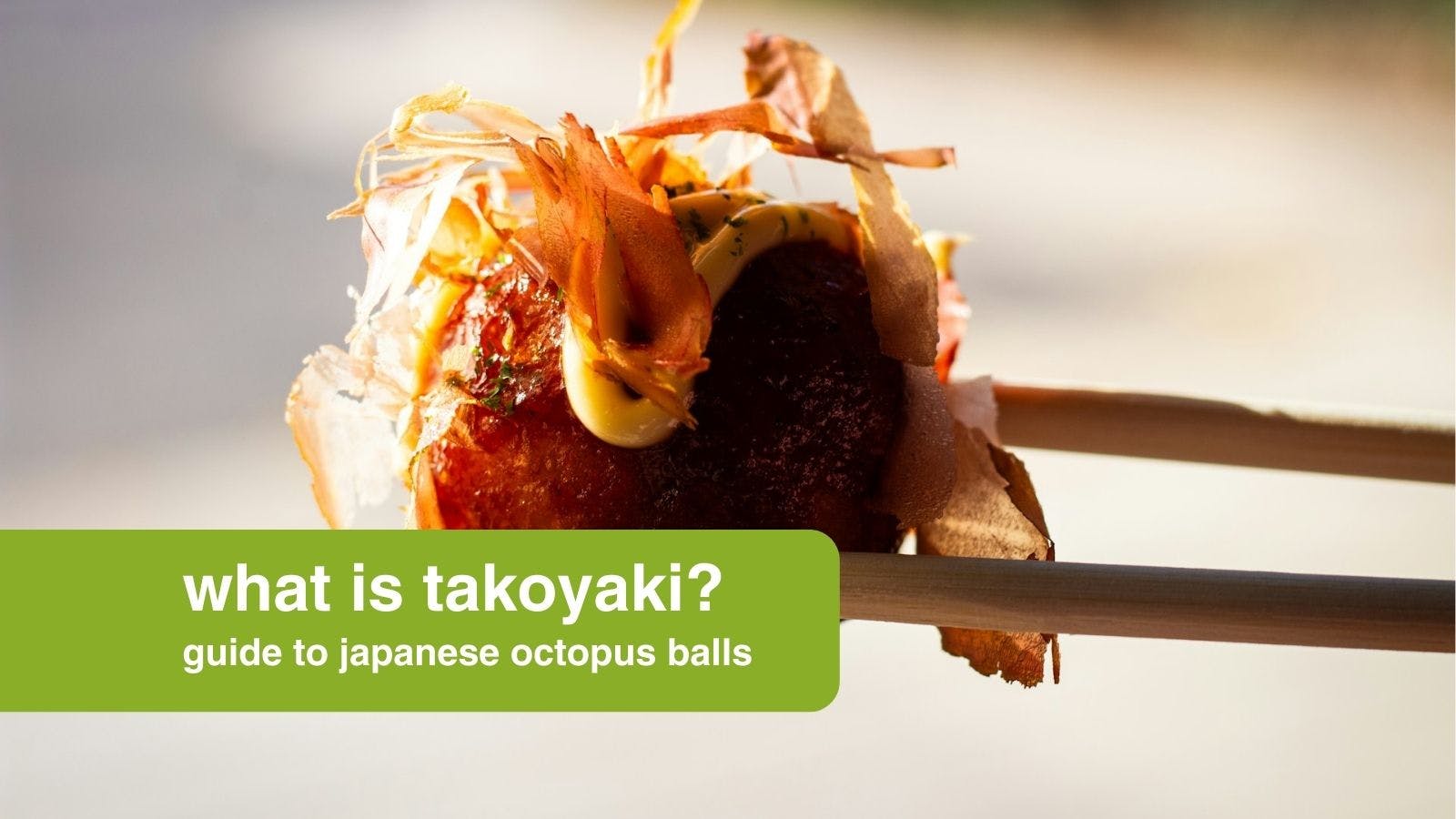your cart
Your cart is empty.
What is Takoyaki? Guide to Japanese Octopus Balls
A classic Japanese street food, takoyaki is a gooey delight filled with umami. Discover what makes these little octopus balls such a crowd-pleaser.

It’s one of Japan’s most famous street foods. While the country is famous for its light and healthy dishes filled with fish and vegetables, takoyaki is a crispy, carb-heavy, fried delight that brings joy to any soul – and often a burnt tongue!
Takoyaki is now a staple you’ll see in most Japanese supermarkets, but it’s a relatively new creation. Discover what makes these little octopus balls such a crowd-pleaser.
What is Takoyaki?
Takoyaki is essentially batter, usually mixed with octopus and other vegetables, which is then cooked on special ball-shaped grills. The name translates as ‘octopus (tako) grill (yaki)’, similar to other popular grilled foods like yakitori (grilled chicken) and taiyaki (grilled fish-shaped cakes). As with those other examples, takoyaki tends to be a snack for while out and about as opposed to a full meal.
The dish was born in the early 1900s in Osaka, a lively city widely regarded as Japan’s culinary hub, particularly when it comes to street food. It was inspired by akashiyaki, a similar octopus dumpling originating in Akashi city.
Authentic takoyaki is made in specific takoyaki grills, which consist of lots of semi-spherical holes. As the takoyaki cooks, picks are used to turn the fried batter around and create the complete sphere.
In Japan, takoyaki is commonly served in boats, covered in sauce and toppings and eaten with chopsticks.
What Does Takoyaki Taste Like?
The main ingredients in traditional takoyaki are octopus and batter, but even if you don’t like fish, you might like takoyaki.
The octopus in takoyaki is often diced to a very small size. Octopus in takoyaki often blends in with the other ingredients and sauces to create a rich and complex umami flavour.
One of the most important characteristics of good takoyaki is what Japanese call ‘sotokari nakatoro’, which essentially means ‘crispy on the outside, gooey on the inside’. While pictures can make takoyaki look like hard, heavy dough balls, takoyaki’s outer shell is often incredibly thin and houses a very gooey (and often very hot) centre that melts in the mouth.

Common Takoyaki Ingredients
Takoyaki’s two main ingredients are octopus and a flour-based batter, often flavoured with a dashi soup stock. However, there’s much more that goes into an authentic takoyaki recipe.
Takoyaki balls often also contain pickled ginger and spring onion, small but hard-hitting veggies that bring plenty of sharp flavours.
Street takoyaki also contains tenkasu, which are scrap bits of tempura (fried batter) that have fallen off other street foods during frying, which gives the dough an added texture.
What are the Takoyaki Sauces and Toppings?
Originally, takoyaki was served as-is without sauces. However, nowadays takoyaki doesn’t feel complete without its characteristic coverings.
The modern takoyaki style is to have it served with a special brown takoyaki sauce, which can be bought from Japanese supermarkets, and Japanese mayonnaise. It is then sprinkled with aonori (seaweed flakes) and katsuobushi (bonito tuna flakes) which add an extra sharpness to the taste.
How to Make Takoyaki – Basic Homecooked Recipe
Unlike many other Japanese recipes, takoyaki relies on a specialist takoyaki pan to be made. There are some alternatives out there but the level of heat required for good takoyaki often means DIY alternatives, like pop cake makers, don’t deliver that authentic crispy outside and gooey inside. If you want the real taste of takoyaki, you’ll need a takoyaki grill.
Takoyaki also relies on a lot of specialist Japanese ingredients that you can buy from us at Oriental Mart. However, if you’re looking to whip up basic takoyaki for two at home, there are some common substitutes you can use. This recipe will guide you through both options.
Ingredients
- 200g flour
- 450ml dashi stock
- 2 eggs
- 100g octopus
- 1tbsp red pickled ginger
- 2 spring onions
- handful of tempura crumbs (can use panko breadcrumbs)
- takoyaki sauce (can use Worcestershire sauce and ketchup)
- Japanese mayonnaise (optional)
- aonori seaweed flakes (optional)
- katsuobushi (optional)
- Mix in a bowl the flour, dashi stock and eggs to create the batter.
- Prepare the octopus, pickled ginger and spring onions by cutting them all into small pieces.
- Grease your takoyaki grill with oil and put on a medium heat.
- Place a small amount of octopus at the bottom of each well, then fill it with batter. The batter should fill each well (it’s often easier to turn if overflowing compared to if underfilled).
- Add as much spring onions and ginger to each well as you would like – you may want to add different amounts to experiment with personal preferences.
- Allow the batter to cook on one side for 1-2 minutes until a hard, crispy outer shell forms. Then, using a skewer or pick, dislodge the cooked batter and push it on one side so the ball rotates.
- Keep rotating the balls so there’s an even outer shell on all sides; this can take around 5 minutes.
- Once cooked, serve immediately with sauces, aonori seaweed and katsuobushi toppings for the best combination of gooey insides and crispy outsides.
Getting the perfect takoyaki can take a few attempts, but just like pancakes, you’ll eventually discover your perfect technique and flavours to impress all your friends (or just keep to yourself).
Remember, if you need Japanese ingredients for takoyaki, okonomiyaki, or any other tasty treat, you can stock up here at Oriental Mart.
this site uses cookies
We and our advertising partners use cookies on this site and around the web to improve your website experience and provide you with personalised advertising from this site and other advertisers. By clicking allow, you accept the placement and use of these cookies for these purposes. Learn More



